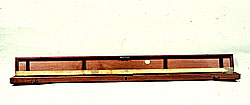 77. Standard meter by J.A. Deleuil
77. Standard meter by J.A. Deleuil
In March 1790 the bishop delegate Talleyrand had proposed to the National Assembly of France the setting up of a unified weights and measures system. The task was entrusted to the
Acadédmie des Sciences which set up a commission comprising Borda, Lagrange, Lavoisier, Tillet and Condorcet, and later joined by Laplace and Monge.
From between the length of a pendulum which strikes the second at 45° latitude, a fraction of the length of the terrestrial equator and a fraction of the length of a meridian, the commission chose the latter as basis for the system. In particular, it suggested the unit of length should be defined as "the tenmillionth part of the terrestrial meridian quarter", that the unit should be calculated from the new measurements of the Earth that were due to be carried out between Dunkirk and Barcelona and that the unit of weight should be defined as the weight of a known volume (a unit therefore deriving from the unit of length) of distilled water at 0°. The decree of 26 March 1791 adopted these definitions and entrusted their carrying out to the Acadédmie . Pierre-Francois André Méchain and Jean-Baptiste Joseph Delambre were given the job of effectuating the geodetic measurements.
After much trial and tribulation, due to internal events in France, legislation of the 19 Frimaire of the year VIII (10 December 1799) drew together the various conclusions of the work and stipulated: "that the tenmillionth part of the terrestrial meridian arc between the North Pole and the equator is definitively fixed, in its relationship with the old measures, equal to three feet, eleven lines and two hundred and ninety-six thousandths".
METRE ETALON / Glace Fondante is engraved on the graduated face of this standard meter, while in the top corner, on the left, is written the maker’s name Deleuil á Paris.
The meter is divided into centimeters, except in the tracts from 0 to 10 cm and from 90 to 100 cm where it is subdivided in millimeters.
It is contained in its original wooden case, lined with red velvet.
F. Bogourdan (1901).
A-M. Motais de Narbonne, J. Alexandre (1988).